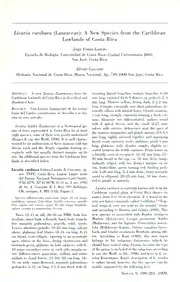
Licaria caribaea (Lauraceae): a new species from the Caribbean lowlands of Costa Rica PDF
Preview Licaria caribaea (Lauraceae): a new species from the Caribbean lowlands of Costa Rica
Licaria caribaea (Lauraceae): A New Species from the Caribbean Lowlands of Costa Rica Jorge Gdmez-Laurito Eseuela de Biologfa, Universidad de Costa Rica, Ciudad Universitaria 2060, San Jose, Costa Rica Alfredo Cascante Herbario Nacional de Costa Rica, Museo Nacional, Ap. 749-1000 San Jose, Costa Rica ABSTRACT. A new Licaria (Lauraceae) from the ternating lateral branches, tertiary branches 6—20 Caribbean lowlands of Costa Rica is described and mm long, crowded by 6—9 flowers on pedicels 2-4 illustrated here. mm long. Flowers yellow, drying dark, 2-2.2 mm long, 6 tepals, externally very short puberulous, in¬ ResumEN. Una Licaria (Lauraceae) de las tierras ternally villous with whitish hairs; 3 fertile stamens, hajas del Caribe costarrieense se describe y se ilu- 1 mm long, strongly connivent forming a thick col¬ stra en este artfculo. umn, filaments not differentiated, anthers ovoid with 2 apical thecae and the small (0.25 mm) Licaria Aublet (Lauraceae) is a Neotropical ge¬ valves with extrorse dehiscence near the apex of nus of trees represented in Costa Rica by at least the stamen; staminodes and glands minute, 0.3—0.5 eight species, some of them very poorly understood mm long, tightly pressed together and appearing (Burger & van der Werff, 1990). It is well charac¬ fused; ovary narrowly ovate, glabrous, pistil 1 mm terized hy its androecium of three stamens with two long, glabrous, style slender, simple, slightly ex- thecae each and the deeply cupulate fruiting re¬ serted between the fertile stamens. Fruits borne on ceptacle with two usually distinct margins on its a broadly conical receptacle 31 —12 mm long, 15— rim. An additional species from the Caribbean low¬ 30 mm broad at the top, ca. 18 mm deep, longi¬ lands is described below. tudinally ridged, with two distinct margins on its rim, lenticellate, green turning red; fruiting pedi¬ Licaria caribaea Gomez-Laurito & Cascante, sp. cels 5—20 mm long, 3^1 mm diam.; berry narrowly nov. TYPE: Costa Rica. Limon: Lfmite norte ovoid to ellipsoid, 20—25 mm long, 10 mm diam., del Parque Nacional Tortuguero, Cano Suerte, red to purple at maturity. 9°36'42"N, 83°45'00"W. 0-10 m, 2 set. 1995 (fl, fr), A. Cascante & A. Ruiz 70S (holotype, Licaria caribaea is currently known only from the CR; isotypes, F, MO, USJ). Figure 1. Caribbean coastal plain of Costa Rica (hence its name), from 0 to 10 m elevation. It is found in the Species inflorescentia paniculata usque 32 cm longa, multiflora; stamina 2-locellata. locellis extrorsis, apicali- very wet forest commonly called “yolillales,” “Trop¬ bus; cupula late conica. usque 42 mm longa, longitudi- ical, tropical, very wet with no dry months” biotic naliter cristata a eongeneribus tliversa. unit according to Herrera and Gomez (1993). This Trees 12-15 m tall, 20—30 cm DBH; bark len- new species is associated with Raphia taedigera ticellate; inner bark yellowish, hard; leafy branch- Martius (Arecaceae), Carapa guianensis Aublet lets minutely puberulous, grayish, solid, terete. (Meliaceae), and the legumes Pentaclethra macro- Leaves alternate; petioles 10—20 mm long, sulcate loba (Willdenow) Kuntze, Prioria copaifera Grise- above, glabrous; leaf blades 18—24 cm long, 8—11 bach, and Crudia acuminata Bentham, among oth¬ cm broad, ovate-elliptic, tapering to an acuminate ers. According to Kurz (1982), this new taxon apex, obtuse at the base, drying chartaceous and belongs to his subgenus Guianensis (which he brownish green, glabrous on both surfaces, with 8— should have named subg. Licaria, because the type 10 major secondary veins on each side, margin en¬ of the genus is included in the subgenus, according tire. Inflorescences paniculate, axillary and extra- to van der Werff, in litt., 1996) and keys to L. ex- axillary to distal leaves, 13—18(—32) cm long, 14- celsa Kostermans. Kurz’s description of L. excelsa lb cm wide, many-flowered, minutely puberulous, is rather broad; however, the two species can be peduncles 5—12 cm long, 1.5-2 mm thick with al¬ readily separated hy the following key: Novon 9: 199-201. 1999. 200 Novon 1 igure 1. Licana canbaea Gdmez-Laurito & Cascante (A. Cascante & A. Ruiz 705). —a. Flowering branch. —b. Flower. —c. Fmit. la. Trees of medium- to high-altitude habitat,(600-) broadly conical receptacle 31-42 mm long, 15— 1 I(X)—2300 m; leaves drying dark in color; inflo¬ 30 mm broad, longitudinally ridged caribaea rescences 5-20 cm long; fruits borne in a cu- pulate or hemispherical receptacle 13—20 mm Paratypes. COSTA RICA. Limdn: same locality as long, 18-12 mm broad, not ridged.L. excelsa type, 3 Mar. 1996 (ster.). A. Cascante A: P. Opay 987 (CR, lb. Trees of low-altitude habitat, 0-10 m; leaves dry¬ USJ), 3 Mar. I *196 (ster.), A. Cascante & P. Opay 986 (CR, ing brownish green in color; inflorescences 13— USJ), 3 Mar. 1996 (fr), A. Cascante A: P. Opay 985 (CR, 32 cm long, many-flowered; fruits borne in a USJ). Volume 9, Number 2 Gomez-Laurito & Cascante 201 1999 Licaria caribaea from Costa Rica Acknowledgments. We are grateful to Henk Literature Cited van der Werff (MO) and to William C. Burger (F) Burger, W. C. & H. van der Werff. 1990. Flora costari- censis. Family #80. Lauraceae. Fieldiana Bot. New Ser. for critically reading the manuscript, and to Car¬ 23: 1-129. men Marin for the illustration. We also thank the Herrera, W. & L. 1). Gomez. 1993. Mapa de unidades Canadian Organization for Tropical Education and bidticas de Costa Rica. Escala 1:685.000. Instituto Geografico de Costa Rica. Rainforest Conservation (COTERC) for its support Kurz, H. 1982. Fortpflanzungsbiologie einiger Gattungen during field trips to Cano Palma Biological Sta¬ neotropischer Lauracean und Revision der Gattung Li¬ tion. caria (Lauraceae). Ph.D. Thesis, Universitat Hamburg.
